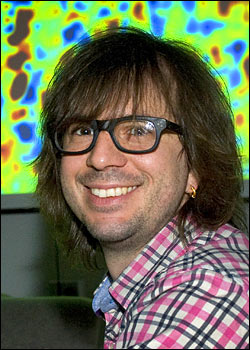Brookhaven Lab Scientist Receives DOE Early Career Research Program Award
May 25, 2011
UPTON, NY — Anže Slosar, an assistant physicist at the U.S. Department of Energy’s (DOE) Brookhaven National Laboratory, has been chosen to receive a $2.5 million five-year research grant under the DOE Early Career Research Program. Slosar’s research proposal to use a new technique to make a map of the distant universe was one of 65 chosen for funding from 1,150 proposals submitted from researchers at national laboratories and universities across the nation. The DOE program is designed to bolster the nation’s scientific workforce by providing support to exceptional researchers during their crucial early years, when many scientists do their most formative work.
“I am thrilled to receive this grant,” Slosar said. “It will allow my colleagues and me to use a new technique to study the distant universe in unprecedented detail. We may be able to unravel some long-standing mysteries of how the universe began and how it is changing from these investigations.”
The Office of High Energy Physics within DOE’s Office of Science will fund Slosar’s research project, titled, “Cosmology with the Lyman-Alpha Forest.” Slosar is participating in the Sloan Digital Sky Survey-III (SDSS-III) collaboration, which operates one of the world’s largest digital cameras, located in Apache Point, New Mexico. Working on the Baryon Oscillation Spectroscopic Survey, one of four SDSS-III projects, Slosar and collaborators created the largest ever three-dimensional map of the distant universe as it appeared 11 billion years ago.
To make the map, Slosar and colleagues used a new technique known as the “Lyman-Alpha Forest.” Instead of mapping the universe by looking at light-emitting galaxies, the researchers observed quasars, the brightest objects in the universe — bright enough to be seen billions of light years from Earth. As light from a quasar travels to Earth, it passes through clouds of hydrogen gas that absorb light at specific wavelengths, which depend on the distances to the clouds. The researchers can determine the structures of the early universe by measuring the shadows that the hydrogen casts on the spectra of quasars. The patchy absorption of light creates an irregular pattern in the spectroscopic data that resembles trees in a forest.
So far, Slosar and his collaborators have looked at 14,000 quasars; the plan for the research project is to analyze 150,000, which would enable the researchers to measure dark energy, the mysterious force that is thought to have accelerated the expansion of the universe. Also, the researchers hope to learn more about neutrinos, ghostlike particles produced in nuclear reactions that power the sun; and cosmic inflation, a period seconds after the Big Bang when the universe is thought to have expanded rapidly.
Slosar received a B.A. in natural sciences in 2000, and a Ph.D. in astrophysics in 2003 from the Cambridge University. From 2004 to 2006, he was a postdoctoral fellow at the University of Ljubljana, Slovenia, followed by a one-year stint at Oxford University. He then came to the U.S. in 2007 to become an inaugural fellow at the Berkeley Center for Cosmological Physics, a joint venture of the University of California at Berkeley and Lawrence Berkeley National Laboratory. He joined Brookhaven as an assistant physicist in 2009.
2011-11287 | INT/EXT | Newsroom










